| 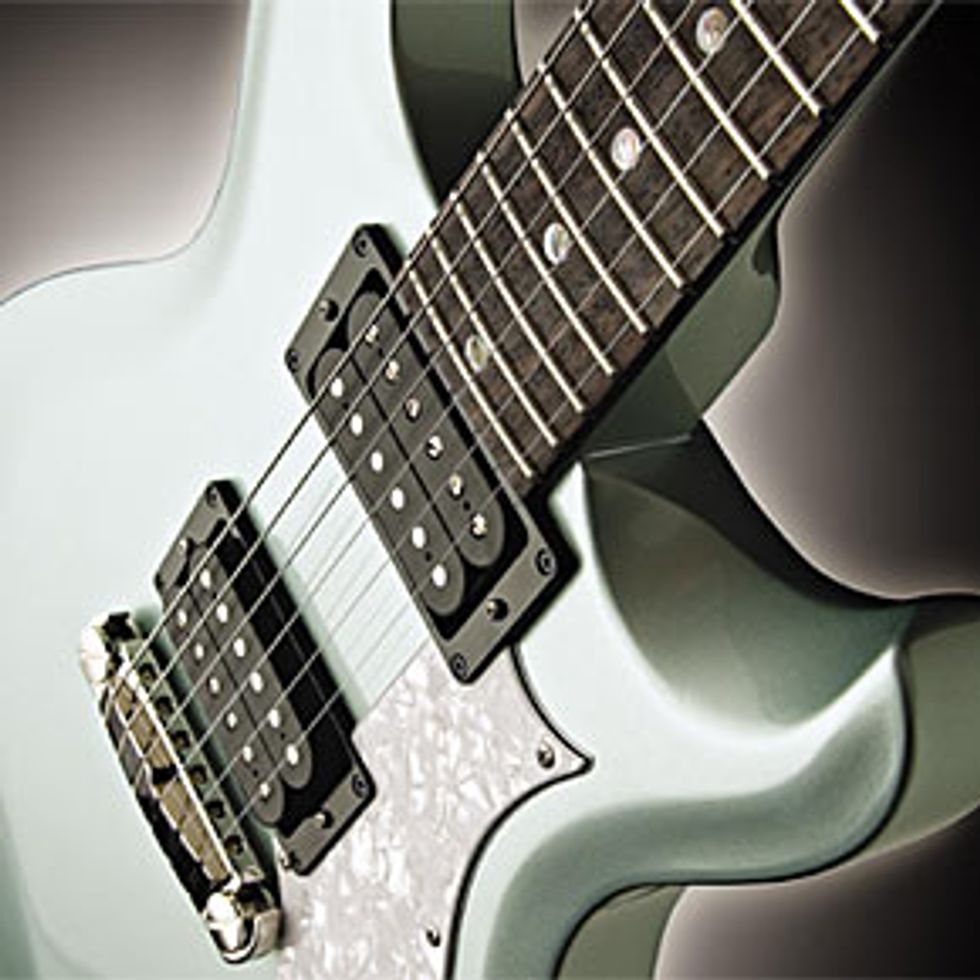 |
These two images are indicative of PRS’ success. The first points toward the iconic stature his company’s guitars now enjoy – when something can be identified by its silhouette, its status as an icon is a given. Second, the fact that Paul’s image is nearly as identifiable as his guitars speaks directly to the amount of face time he has put in, sharing his vision to the guitar faithful.
Now, let’s try this exercise again, only this time try to conjure up the last few things you associated with PRS. Just play along, I’m trying to prove a point. I’ll venture a guess and say one of the notnormally- associated-with-PRS images is a slab-bodied guitar. Sure, Paul’s earliest creations, his first two six-strings in fact, were LP Junior variants whose bodies were unabashed, form-follows-function slabs. But early on, by his second year of making guitars, Paul had already begun carving his tops.
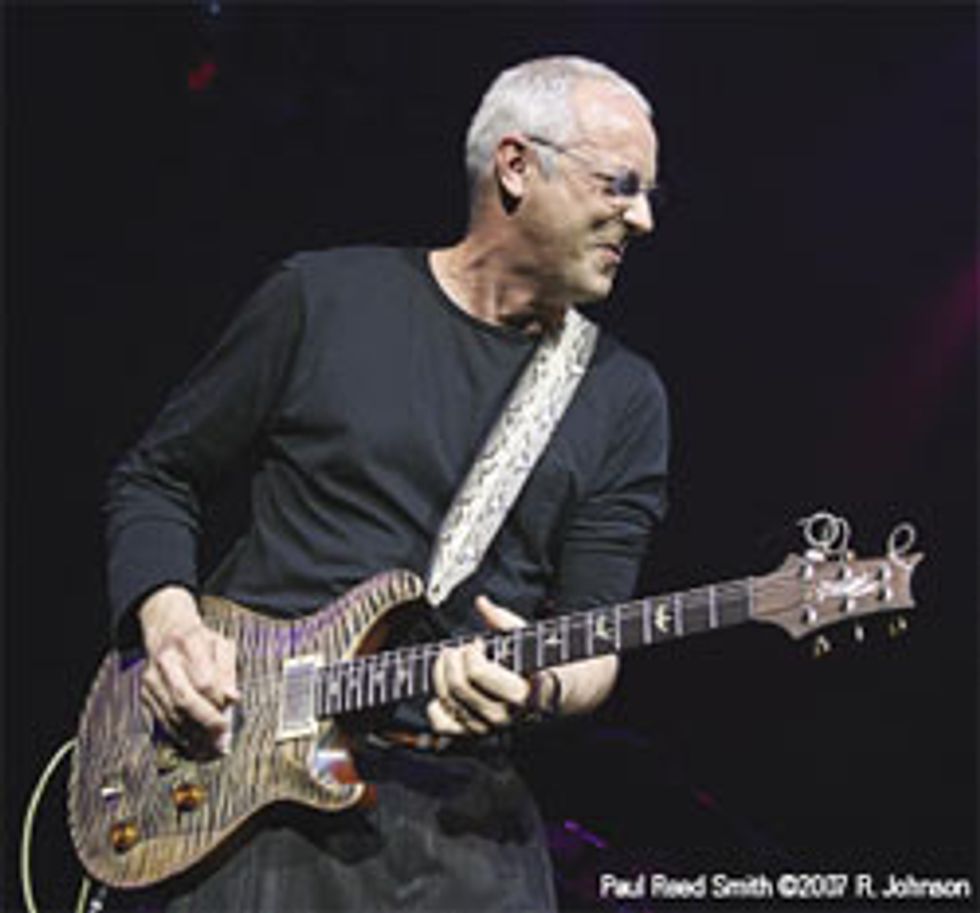 The next decidedly non-PRS concept is the use of pickguards, which makes perfect sense. Why bust your ass trying to achieve just the right contour on painstakingly sourced and sorted figured maple only to eventually hide it with a hunk of plastic? In all honesty, the words “PRS” and “pickguard” probably appear together in the same sentence almost half as frequently as the words “banjoplayer’s” and “Porsche.” Earlier PRS models, such as the EG series produced in the early to mid-nineties also featured pickguards, but they weren’t set necks, and were therefore not perceived of as “real” PRSs by many players, and were ultimately less than commercially successful.
The next decidedly non-PRS concept is the use of pickguards, which makes perfect sense. Why bust your ass trying to achieve just the right contour on painstakingly sourced and sorted figured maple only to eventually hide it with a hunk of plastic? In all honesty, the words “PRS” and “pickguard” probably appear together in the same sentence almost half as frequently as the words “banjoplayer’s” and “Porsche.” Earlier PRS models, such as the EG series produced in the early to mid-nineties also featured pickguards, but they weren’t set necks, and were therefore not perceived of as “real” PRSs by many players, and were ultimately less than commercially successful. Another term not immediately associated with PRS is high-gloss nitrocellulose lacquer. By the time PRS as we now know it began at the ’85 NAMM show, the big two had been shooting polyurethane finishes for a combined 37 years – Fender since ’69 and Gibson since ’64, and the fledgling PRS followed suit. Manufacturers realized the dealer’s need to keep guitars looking new even after the occasional bump that occurred when people demoed new instruments. Nitrocellulose lacquer doesn’t hold up visually to these light knocks and scuffs nearly as well as poly, and the industry as a whole seemed to agree that attribute was worth the tonal trade off. In recent years PRS has dabbled with satin lacquer finishes, but nothing glossy.
So, let’s review: PRS-inducing words and images are to include curvaceous body shapes, Paul, bird inlays and beautiful carved maple tops. Non-PRS words and images include, but aren’t limited to the following: slab-bodies, pickguards, and thin nitro finishes. Why is any of this relevant? Because the following interviews; the first with Joe Knaggs, the man behind the new mold-breaking Mira; and the second with Austin’s very own David Grissom, demonstrate that Paul’s not keen on sitting on either his hands or his laurels. The PRS DGT – David Grissom Trem – features, among other things, a nitrocellulose lacquer finish. The Mira features a contoured slab-body and big old pickguard, right there for God and everyone else to see.
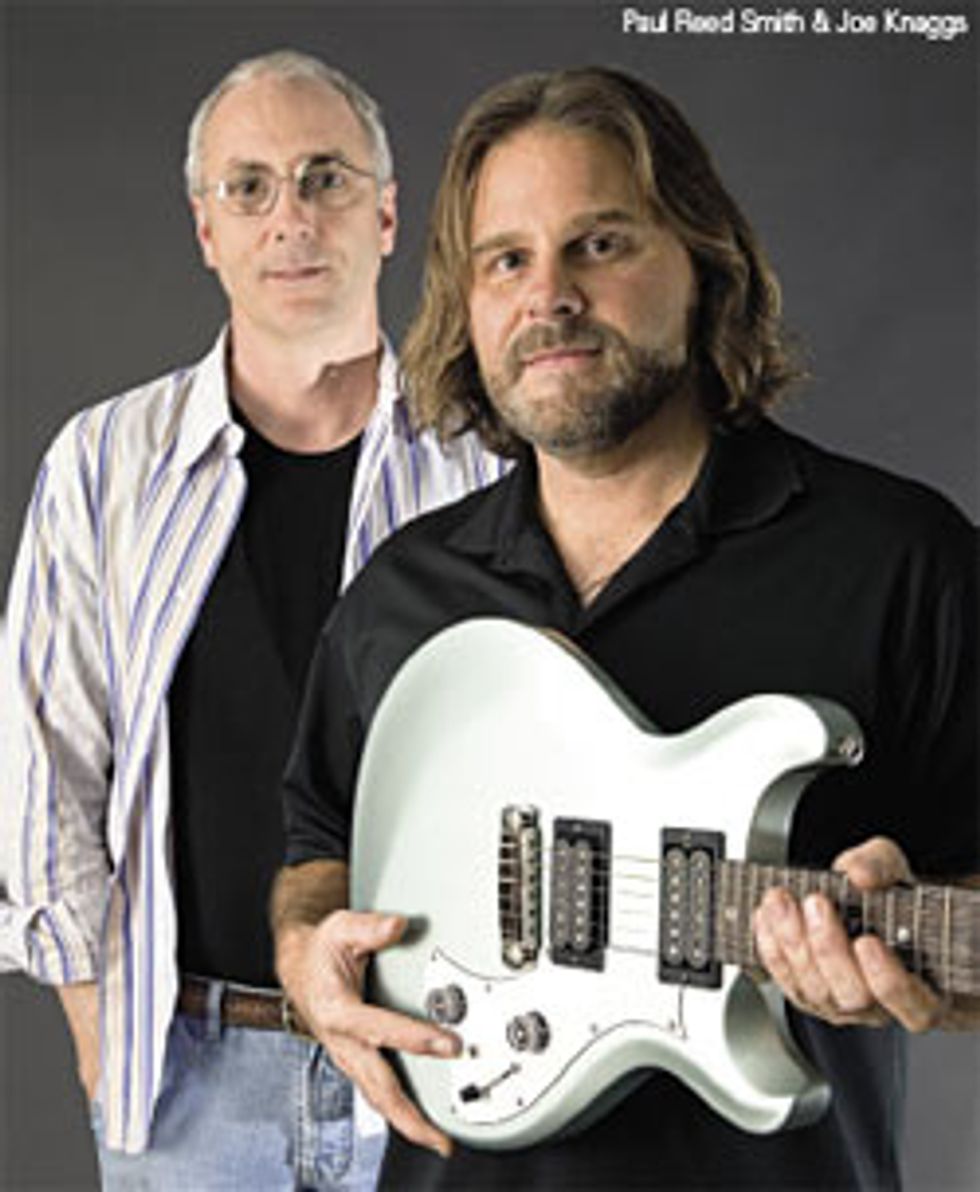 Mira Image
Mira ImageWe’ll begin with an interview with the man behind the guitar, Joe Knaggs, Director of Research and Development as well as the Director of Private Stock for PRS.
First obvious question: where did the name Mira come from?
JOE: The name actually originated from Rick Hodgson’s [PRS Domestic Sales] insistence that the guitar have an actual name. He felt the guitar should have an identity all its own, and a name would accomplish that better than a number. So we had a contest here for all the employees to name the guitar – we actually developed the guitar, made it and took pictures of it and then invited everyone to “name that guitar.” When we went through all of the entries, we probably had 35-40 names that we really liked, but every time we would look one up, it was already trademarked in the industry. It actually started with bird names – like “the Osprey” – but they were all taken. It was unbelievable.
I ended up just going online and looking up the names of a bunch of stars, because I felt like this guitar has a retro, fifties vibe and a lot of the names back then, in both guitars and cars, were referencing space – planet names, galaxies. Finally, after five or six meetings, we finally came back across the name Mira and said, “Hey, that’s a good one!”
Later on we discovered that this star named Mira moves unusually fast, and it’s also Latin for “wonderful,” so it all worked out.
Where did the idea for this guitar originate?
We had been talking for years – between Peter Wolf [Director of Sales and Marketing], Jack Higginbotham [President], Rob Carhart [Production Manager] and myself – about coming out with a different PRS body shape. I had actually experimented with a few other designs before this one and we just felt like the time was right. We wanted to come out with something that featured more of a retro look.
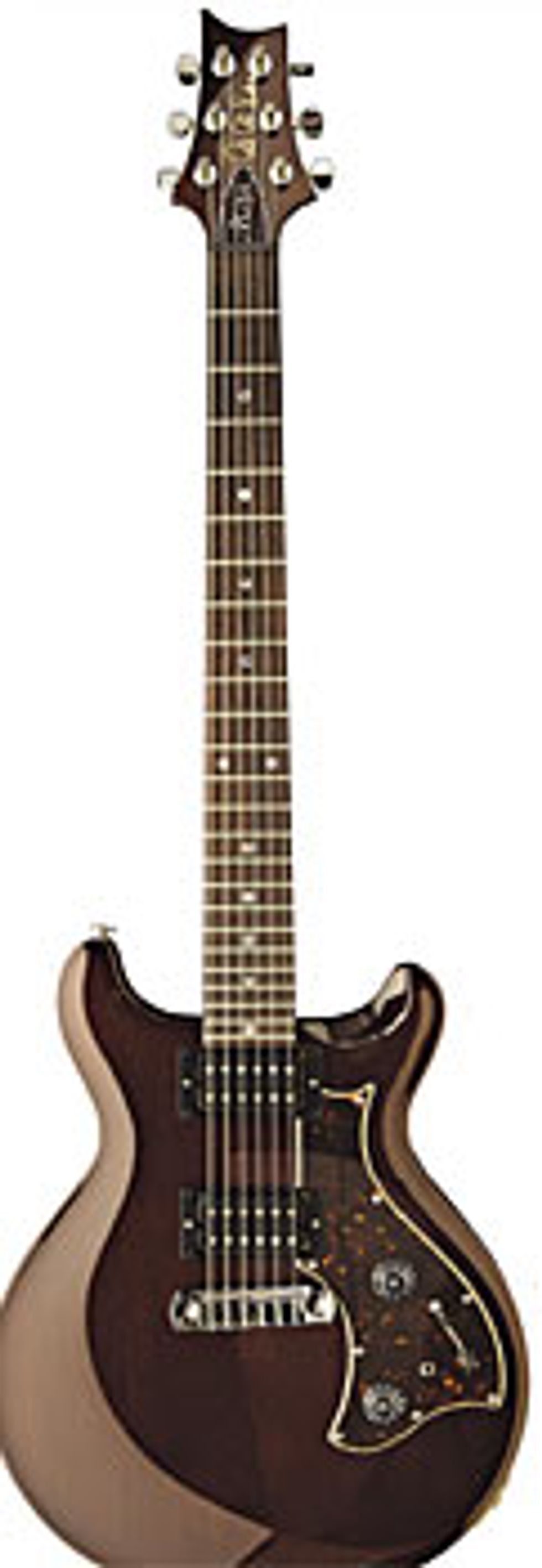 It definitely retains its identity as a PRS, but it also has a distinctly vintage look.
It definitely retains its identity as a PRS, but it also has a distinctly vintage look. Exactly. I wanted to come up with a guitar that felt a little different than our other guitars – how it sat on you, how it felt, how far the neck came out from the body, etc. The concept started in product development meetings with everyone’s input, then I went and designed it.
Did you make the first one?
Yeah, I made the first one myself – I drew the body shape – and the product development team also had a lot to do with it. Jack (Higginbotham) said, “Why don’t we take the Santana shape and make it bigger?” Also, Peter felt that the guitar should be bigger. So that’s basically where I started. So, what I did was start with a Santana shape, made it a little bit bigger and then changed the arcs on the lower bout – I made it a little squarer on the bottom so it’s not quite the same profile as the Santana. To me, the upper and lower contour of the Santana is much rounder – like a figure eight. The Mira has lines that are a little more squared off. Look at a Fender, for example – the bottom is pretty flat. I was just trying to combine some looks to forge a unique identity.
Also, another objective was to create a guitar that had the carved look but played like a flat top. My main goal when designing this guitar was to preserve an identifiable PRS look, but gear it towards a slab-bodied guitar.
What was Paul’s response to the direction that you were taking the design?
Paul has always moved forward with our guitars, continually making them better and better. He was responsive to it, especially once I made one and brought it to a product development meeting. That’s generally when it really hits home with everyone – whether people like it or not. Until that point, it’s just an idea. Once he saw it, he really liked it, and the responsiveness increased from that moment on.
Isn’t this the first set neck PRS with a pickguard? How did that decision come about?
Yes it is. It was something that I wanted to do for two reasons: the first was because I wanted to wire up the electronics and just put them into the guitar. We can wire up a pickguard and just drop it into the body. It makes production easier – not a ton, but enough that it helps. The other benefit of a pickguard is it gets all of the electronic cavities off the back of the guitar. There are no recesses or backplates; I wanted the back of the guitar to be uninterrupted and clean.
How has the reaction to the pickguard been?
People really like it. You know, to me, what the pickguard does is catch the eye of people who might not normally look at our guitars by giving the Mira a kind of retro look – a different feel.
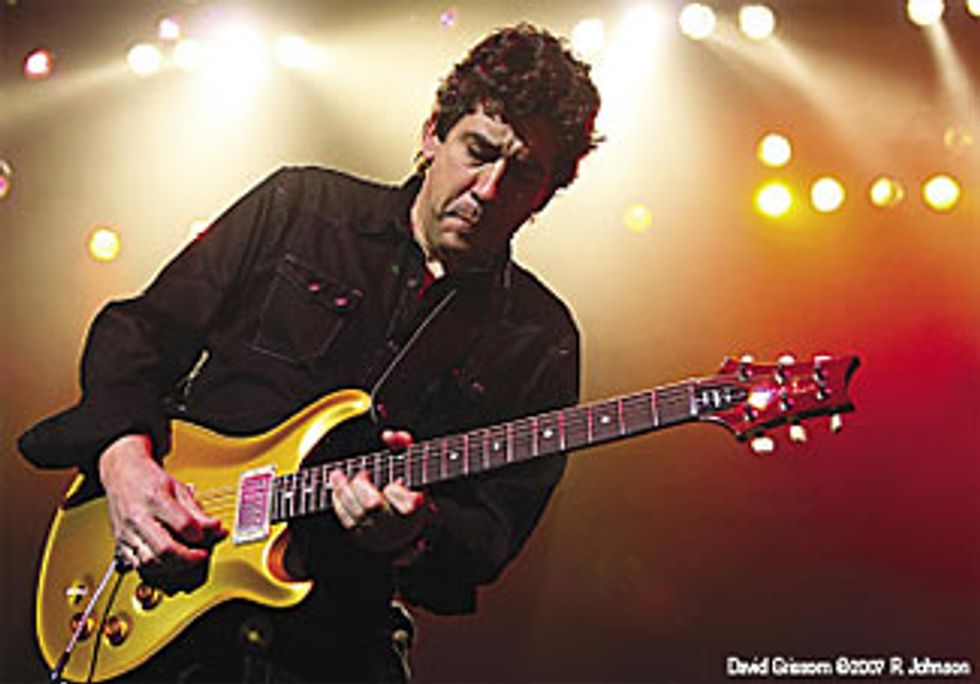 What was the impetus for the thinner body depth? Was it a tonal decision?
What was the impetus for the thinner body depth? Was it a tonal decision? I wanted to give the Mira a different feel when it was against your body; I wanted the guitar to be closer. And I absolutely think it sounds different than our other guitars.
Are the pickups your design?
Paul came up with the pickups. He started with the SC 245 pickups and modified them, and they ended up perfect for this guitar – they’re one of the things that make this guitar what it is. When you listen to them, they’re clear but powerful. They kind of lean away from that seventies distortion sound and more toward a clean, humbucker sound. See, to me, a lot of today’s music relies on strumming, not guitar solos. When there are solos, they’re pretty short, so I think the Mira is a good guitar for those types of sounds.
 Did that just happen or was that the goal while Paul was voicing the pickups?
Did that just happen or was that the goal while Paul was voicing the pickups? We always wanted it to be really clear, not saturated.
That’s interesting. It sounds like it’s tailored for indie music, and the guitar seems to have found a home with a lot of those bands.
Exactly, and I’ll tell you, that’s one of the things that we were aiming for. We talked about it, and I looked at the guitars that some of the indie bands are playing. Many of them are playing more retro instruments and focusing more on tight rhythms than flashy solos. We made a few guitars and sent them out to some bands and got a really good response. There’s no question – it’s been a really good fit.
What would you deem the coolest part about designing this guitar?
I think the coolest part about it was probably discussing what we wanted accomplish and then drawing it, cutting it out, building it and having it all work out. Like I said, I wanted it to sit between a carved top and a flattop guitar, so it had a slab-bodied feel, but I also wanted people to see it and know immediately that it was a PRS. The coolest part about it was getting to see that goal happen.
Another cool thing about developing the Mira happened when this guitar was moving down the production line. We have 200 employees and a lot of them are guitar players in their mid to late twenties. When this guitar was going through the factory for the first time many of them were just totally into it. It was a great process and amazing to see the reaction to the guitar on employees’ faces. This is always a great sign to me.
From Austin to Annapolis
We also had the good fortune of sitting down with David Grissom, the man responsible for the DGT as well as a metric ton of great guitar music. He was kind enough to share some of the tone recipe used to brew up his signature model as well as a few thoughts on the state of guitar in general.
You’ve been associated with PRS for quite a long time; when did they first approach you about doing the DGT?
DAVID: Well, that’s sort of an involved story. I don’t know exactly when it came up, but I’ve worked with Paul for 20 years now – literally. Six months after I bought a PRS, I met Paul and he got me the Gold-Top (Gold Metallic) Standard that became my main guitar for a lot of years. We kept in close contact, and then around ‘92-ish, I started talking to him about ordering a guitar that was different than anything that they had going, and that guitar turned into the McCarty model. We continued our relationship and continued to talk about guitars and what we could do to make that guitar better. I’m guessing around three years ago, we started discussing that maybe it was time to think about a completely different model. I had always favored McCarty Trems – a guitar that I had a lot to do with in the beginning – and it became a guitar that you couldn’t get from PRS; they had to be custom-ordered, and then it was like a year wait. So it just seemed logical for both of us to create another model.
I was making lists of everything that I would do differently and trying to incorporate some of the little anomalies that were common to my two best PRSs that I’d owned over the last 15 to 18 years. We came to the agreement that we were going to go full steam ahead about two years ago, and I spent the next year after that basically working on pickups. They probably could have released it at Winter NAMM last year, but for whatever reason they thought it would be a better idea to wait until Summer NAMM. So, the accurate short answer would be that we really started working on it full time two years ago.
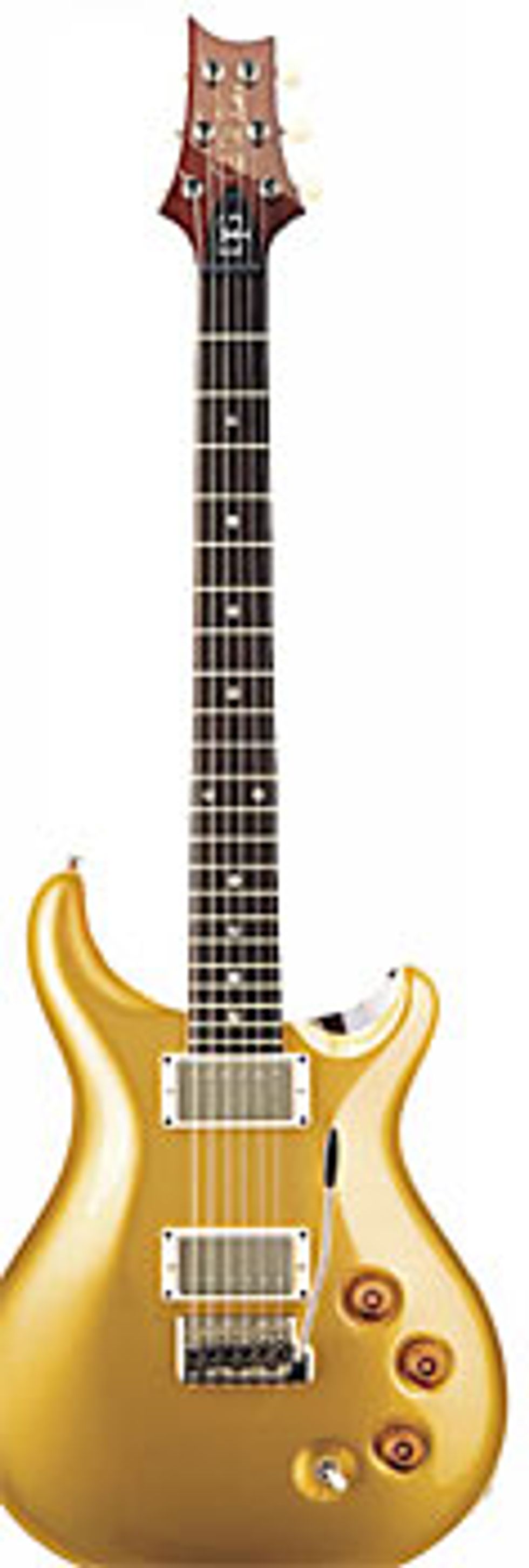 Maybe they waited for Summer NAMM because of the Austin connection?
Maybe they waited for Summer NAMM because of the Austin connection? Maybe that was it – they had a bunch of other models coming out. Getting the gloss nitro thing had been a real challenge, and I think they wanted to make sure it was really done right.
You had mentioned it’s been a 20-year relationship with Paul Reed Smith and I’m having a hard time remembering you without a PRS in your hands, to be quite honest. What led you to PRS in the first place?
Well, when I moved to Austin in ‘83, I had a really nice Strat – still have it. But that was the only electric guitar that I owned for some time, and when I got down here, everybody was playing a Strat, and it just sort of – I don’t know, I just felt like I wanted to do something different. In ‘85, when PRS went from their little custom shop to an actual, full-blown company, I started looking at them and thinking, well, that Seafoam Green thing there looks kinda cool. So really, I just wanted to play something that no one else around here was playing, and there was a dealer in Dallas that had a Seafoam Green mahogany model and I went up there, checked it out and bought it from him. I’ve really never looked back.
Earlier you said that your model is based on the McCarty Trem. Can you give us the litany of what’s different between that and a standard McCarty – if someone ordered a McCarty Trem, what would be the difference between that and the DGT?
The main differences are that the finish is gloss nitro, which is quite a bit different than the standard PRS finish. It makes a difference on the tone of the guitar as well as the aesthetics – I love the look and the feel of it. One of the other big changes is the pickups. As I said, I spent about a year on them. There’s a guy here in Austin named Ed Reynolds who does all of my guitar work, and he built a test guitar where we could change the pickups out in about 15 seconds. In other words, they were top-mounted; they slid in and there were terminals on top of the guitar, so what we were able to do was make it more of a science when A/B-ing pickups, as opposed to having to take the strings off, unsolder, unscrew – all that – where your mind has plenty of time to forget what you heard ten minutes ago.
Like the old Dan Armstrongs where you could slip the pickup in and out?
Yeah, it was pretty much like that, although not as pleasant looking. It was kind of a Frankenstein, but it worked. Over the course of the year, Paul probably built me 40 pickups and at the same time we were A/B-ing a lot of other manufacturers’ pickups, deciding what we liked, what we didn’t like. We had benchmarks that we were sort of able to relate to in terms of, “where are we, really, in the real world, when we compare to these pickups?” At the same time, I have a ‘59 335 which has as good a sounding PAF in it as I’ve ever heard, and that became the real benchmark – A/Bing it against that guitar.
I can imagine...
What we found and what Paul taught us was that everything matters in a pickup, from the type of wire, the thickness of the wire, the type of magnets, the amount of wax potting, the type of material you use to pot it, the material of the covers – all those things. So the process of designing this guitar was a luxury from the beginning in all respects, but with regard to pickups, he’d set us up and we’d A/B it with other things that we thought we liked best previously, and we’d decide what we wanted to tweak. I’d call him and two days later another set of pickups would be at my front door – or sometimes two sets of pickups. It was this filter of continually trying to get what I heard in my head into a pickup and I really, honestly think we got it. I’m super pleased with it, so that’s a big difference.
The other thing about the guitar that most people will notice right away is that there are three knobs on it – two volumes and one tone. I felt with the McCarty, and most PRSs that only had one volume control, you were losing all the nuances you had when you had both pickups on and dual volume controls. By changing the relative levels of the pickups you get all kinds of different sounds. Also, I’m not really sure of the science behind it, but I was pretty emphatic about wanting the push-pull knob on the tone control so when you pull it up to go to the single coil setting it’s more of a 75 percent on vibe. I always felt it was too drastic otherwise; it got too thin, too bright, and too quiet. To me, the tap setting is much more useful now.
 At Summer NAMM, I was listening to you play and I noticed when you did go into the coil tap modes, it sounded more P-90ish, like a fat Tele, rather than that drastic, almost over-processed kind of thing a lot of the seventies guitars used to do – the old Ibanezes that had the coil tap and all that. The DGT seemed much more musical and fuller.
At Summer NAMM, I was listening to you play and I noticed when you did go into the coil tap modes, it sounded more P-90ish, like a fat Tele, rather than that drastic, almost over-processed kind of thing a lot of the seventies guitars used to do – the old Ibanezes that had the coil tap and all that. The DGT seemed much more musical and fuller. Yeah. That’s what we were going for, and I’m glad you heard it.
On your pickups, were you coming from the direction of taking a really nice PAFvariant that has a good clean sound and overdriving that, rather than taking a high-output humbucker and trying to clean it up?
Absolutely. I mean, if you start out with a 12k pickup, you can’t make that any cleaner unless you use a tap. I feel like there’s been a sweet spot with that whole process in terms of the number of windings and how much output a pickup has. We tried to get a pickup that was articulate on all six strings – including the low strings – and at the same time, not harsh on the top strings, which I think lends itself to much more nuance, and it’s more versatile. I think it’s much easier to step on an overdrive pedal or dial in a little more overdrive than it is to try to work backwards from a super-high output pickup that just sounds cloudy.
Last night when I was getting ready to speak with you, I went onto PRS’ site and I checked out the demo of your guitar as played by J Hayes, PRS Product Support Manager. He was a great picker, and was playing the same riff over and over with different settings, and I was really taken aback by how flexible that guitar is for the type of design that it is. Does that need for flexibility stem from your career – going from Lucinda Williams to playing with Ringo Starr to playing with the Dixie Chicks?
Yeah, I guess. I think that the inherent nature of the guitar itself allows for a lot of flexibility, with the scale length being between Fender and Gibson. To me, that’s a big factor, especially in being able to get the low strings to be articulate and still having a fatness on the top strings. Everything about the guitar is no compromise from my perspective.
Also, as far as versatility, one thing I always really loved was the sound of bigger strings, but I also want to be able to bend them like I can, so that I can play more country stuff – or even if it’s rock – I want to really be able to bend the shit out of the strings. So, we – I mean I – sort of arrived at a fret wire gauge that I think allows me to do that with the scale length. The guitar comes with .011 to .049s, so that’s kind of a versatility thing, too, where you’ve got the big strings. Still, most people who play it – in fact everybody that I’ve talked to that picks it up – just can’t believe there are .011s on there.
For what it’s worth, for the last 14 years my main guitar was a McCarty – a gold ‘94 with tremolo. And I’ve hardly touched it for the last year while I was playing these guitars, the prototypes and everything. It’s actually been longer than that, because I had ‘em on the whole Dixie Chicks tour last year and at Summer NAMM they brought the first eight off the line and I took two of those. Since then, I’ve never touched that Gold-Top and I actually just sold it.
Well there’s an endorsement. That’s nice!
I just got to the point where it was like, “It’s been nice to know ya, and I’ve had a blast, but I’m not gonna play you.”
Well, how does it feel to know that if you’re playing in Omaha and the truck’s stuck somewhere else, you can find a replacement?
It makes me feel really good. I mean, that’s kind of the whole broad issue for me with the price of vintage instruments. They’re almost out of the reach of almost any player – the players I know. I’m just really excited about the fact that, to me, the best guitars and amplifiers are being made right now, compared to any time in my lifetime. We have the luxury of getting instruments and amplifiers that are better than ever. So yeah, it’s not only exciting for me that if one falls off the stage and breaks that I can get another one, but it’s also that I honestly feel like I can tell people, “If you want what I’m playing, and you want a great instrument that’s reasonably affordable, you can go get one of these things and I guarantee it’s gonna be a great guitar.”
| If you’d like to hear this great guitar in action, check out David’s latest album Loud Music on Wide Lode Records, available on iTunes and CD Baby. |
Mira Demonstration:
DGT Demonstration:
PRS GUITARS
prsguitars.com


























